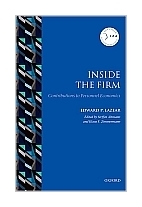Inside the Firm:
Contributions to Personnel
Economics
Key contributions from eminent economist Edward Lazear whose
pioneering work in personnel economics has influenced modern labor economics
Winner of the IZA Prize in Labour Economics 2004
Original section Introductions complement the classic papers
Combines empirical and theoretical research
How should firms select their employees? How should they design their compensation
schemes such that employees are motivated to work hard? How do the performance and
compensation of teammates influence workers' motivation and productivity?
Personnel economics examines human resource practices and answers questions that are of
paramount importance for business leaders around the globe. In this volume, Edward P.
Lazear, a founding father of personnel economics and winner of the IZA Prize in Labor
Economics 2004, takes stock of the economic analysis of personnel management, and the
advancements and achievements that have been made in this field over the past 30 years.
The book contains an impressive selection of Lazear's most important papers. It provides a
unifying approach to human resource practices and a useful reference on personnel
strategies such as hiring, motivating, and training an effective work force.
Readership: Academics, students, labor economists, and officials interested in labor
economics, business management, human resources, and employment.
Table of Contents
I: Introduction by the Editors: Edward P. Lazear: A Founding Father of Personnel
Economics
II: What Is Personnel Economics?
III: Explaining Labor Institutions in Business
Introduction
1: Why Is There Mandatory Retirement?
2: Pensions as Severance Pay
3: Job Security Provisions and Employment
4: An Economic Analysis of Works Councils
5: The Peter Principle: A Theory of Decline
IV Compensation Structures
Introduction
6: Rank-Order Tournaments as Optimum Labor Contracts
7: Salaries and Piece Rates
8: Performance Pay and Productivity
9: The Job as a Concept
V Social Interactions and Personnel Economics
Introduction
10: Peer Pressure and Partnerships
11: Pay Equality and Industrial Politics
12: Culture and Language
VI: Skill Acquisition and Personnel Economics
Introduction
13: Firm-Specific Human Capital: A Skill-Weights Approach
14: Educational Production
15: Speeding, Terrorism, and Teaching to the Test
16: Entrepreneurship
VII: Personnel Economics - The Past and Future
560 pages, Hardcover
Księgarnia nie działa. Nie odpowiadamy na pytania i nie realizujemy zamówien. Do odwolania !.


